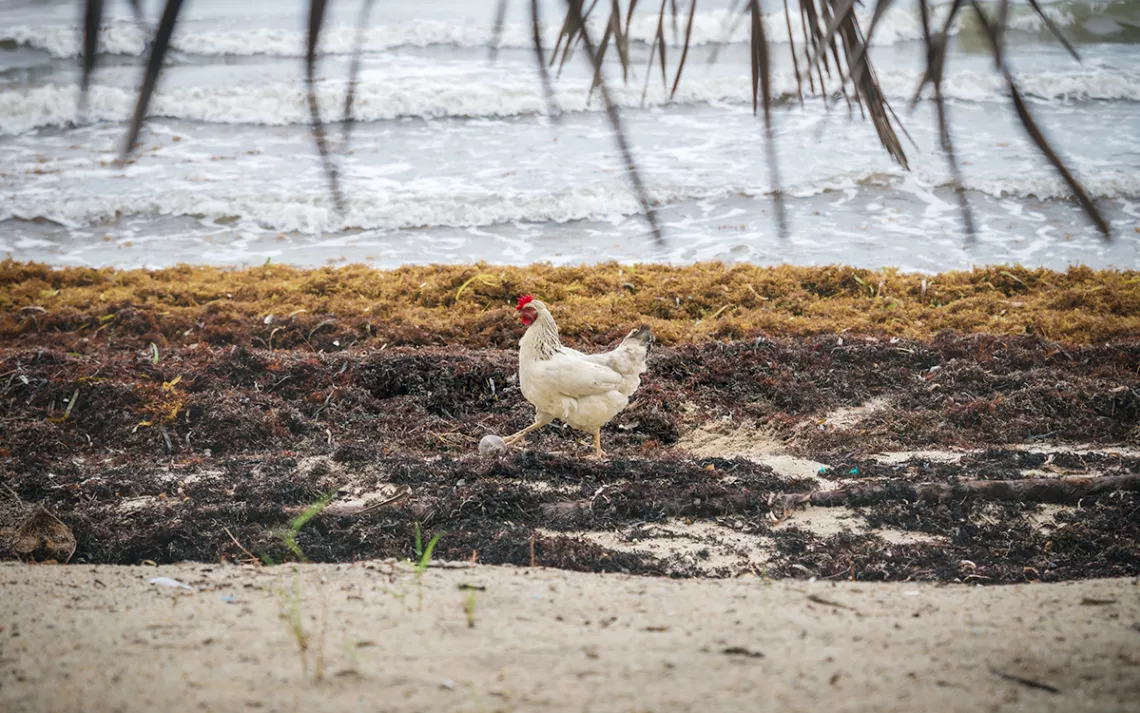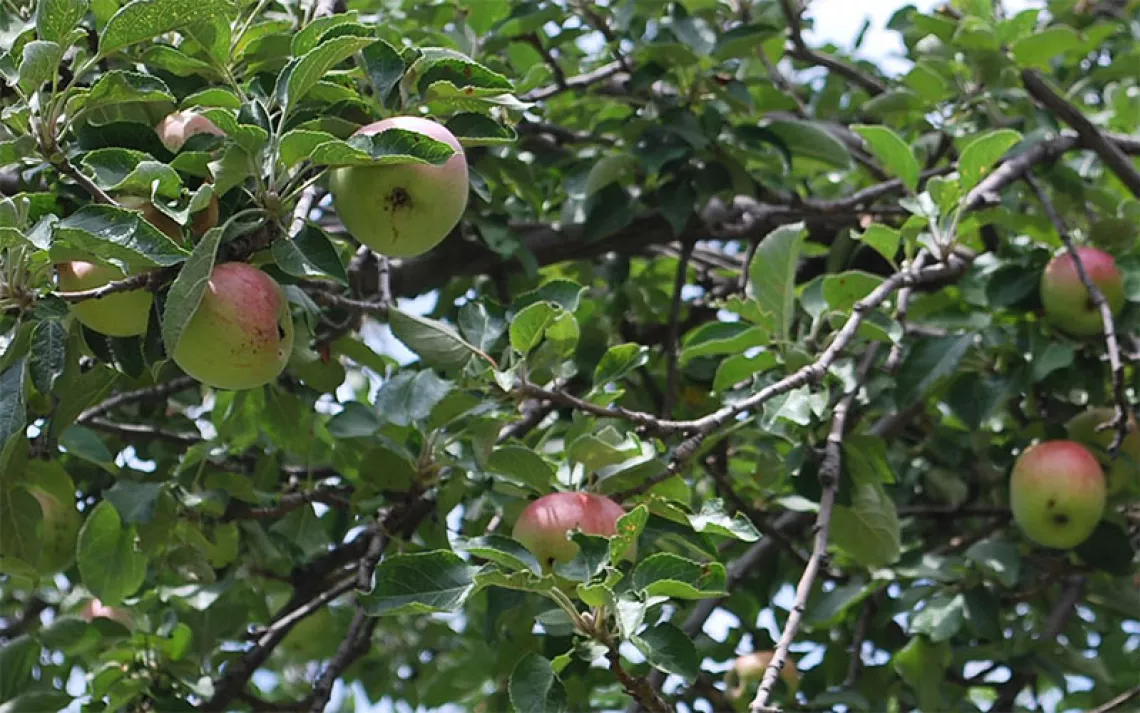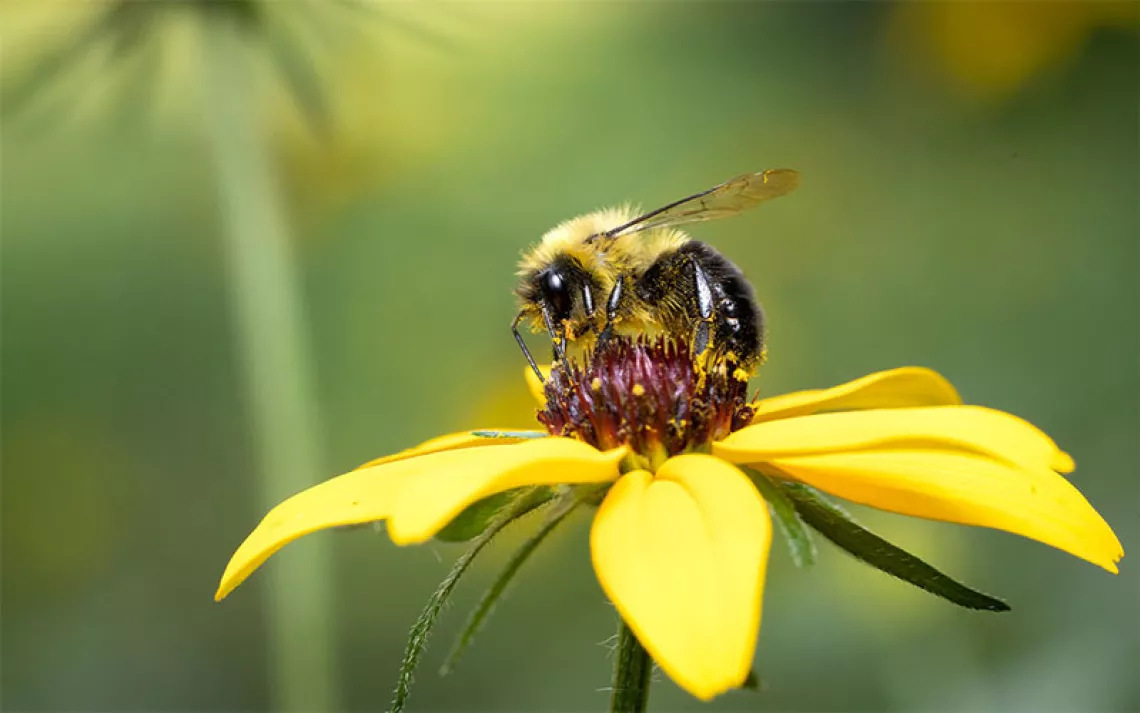Rotten Egg Smell in Paradise
A smelly mystery on the shores of Belize

Chicken walking past piles of sargassum in Hopkins, Belize. | Photo by Loeskieboom/iStock
At first glance, I thought it was an oil spill. As I flew over the Caribbean Sea near the coast of Belize, the water was so clear and shallow that I could see to the bottom of the ocean from the height of the plane. But floating on top of all that crystalline turquoise were mile-long, amorphous brown blobs with long, skinny tails trailing behind them like ropes, stretching off into the horizon.
Upon landing on the island of Ambergris Caye, I was presented with another puzzle. Between notes of salty sea air and the sharp scent of gasoline that powers the island’s fleet of golf carts was the distinct odor of rotten eggs.
Both the visual and olfactory mysteries, I would learn, arose from a shared origin: sargassum seaweed. Evidence of the inundation was everywhere: Sargassum floated in the water off the piers, lay piled in knee-high mounds on the side of the road, and was raked into thick carpets on one side of the beach by hotel employees who tried to keep it out of sight (if not out of smelling range) of tourists.
Historically found in the Gulf of Mexico and Sargasso Sea, sargassum began showing up in unexpected places just over a decade ago. Now it’s found everywhere from the coast of West Africa to northeastern South America to the Caribbean. Blooms of the floating algae are now so consistently large that they’ve been “easily visible from space” almost every year since 2011, says Elizabeth “Libby” Johns, a recently retired oceanographer with NOAA’s Physical Oceanography Division, and 2022 may turn out to be the biggest year for sargassum ever recorded. The months of June and July set new records for sargassum levels in the Atlantic.

Sign up to receive Sierra News & Views
Get articles like this one sent directly to your inbox weekly.
With this action you affirm you want to receive Sierra Club communications and may vote on policy designated by the Sierra Club Board.
Sargassum in the open sea plays a useful role—the floating rafts of seaweed provide habitat for fish, sea turtles, crabs, and marine birds. But it causes problems when it floods shorelines. According to Raymond Mossiah, a member of Belize’s Sargassum Task Force and a chief officer at the Ministry of Tourism, masses of sargassum in recent years have killed mangroves and seagrass, triggered large fish kills, buried sea turtle nesting sites, and smothered coral reefs.
When sargassum decomposes, it releases hydrogen sulfide, which can cause respiratory problems. And even if someone’s not breathing in enough to do damage to their health, there’s still that pervasive rotten egg smell. In Belize, which relies on tourism for 40 percent of its GDP, that smell is an economic threat.
“One of the main things in our portfolio is nature-based tourism. Destinations have told us that they have seen 10 percent, 20 percent, and more cancellations because of sargassum,” Mossiah said. “That affects us tremendously.”
So what’s causing the excessive growth of sargassum populations? One obvious suspect, put forward by the UN Environment Program, is climate change. As waters warm, sargassum’s range is expanding—or that’s the theory.
Chuanmin Hu, a professor of optical oceanography at the University of South Florida, isn’t so sure. The rate of ocean temperature change is too slow to account for the dramatic explosion of sargassum over the past 10 years, he told me. If climate change is spurring sargassum’s growth, he thinks, it’s more likely through indirect means. Now that droughts are making it harder to grow food, farmers may be using more fertilizer and clearing more forest, resulting in the kind of nutrient runoff into the ocean that could feed a sargassum boom. But he noted that “nobody has the critical data” yet to test these hypotheses.
NOAA’s Johns agrees that some influx of nutrients is feeding the sargassum boom but adds that the source of those nutrients is the subject of much controversy. “It is tempting for people to try to find a cause for the sargassum inundation events that could potentially be controlled,” she said. But her research has led her to conclude that it’s more likely the result of wind patterns and ocean currents that lead to subsurface nutrients rising to the surface where sargassum can utilize them.
While researchers look for answers, Belizeans are trying to adapt. Currently, much of the seaweed is removed from beaches manually, then sent to landfill or other designated dumping sites. But the country’s Sargassum Task Force is looking for alternatives.
Booms that are intended to keep sargassum mats from washing ashore have been employed by resort owners with “mixed results,” said Mossiah. He and his colleagues have also been looking at outfitting boats in ways that would allow them to collect the sargassum and dispose of it before it reaches land, but those collection systems remain prohibitively expensive for now.
If sargassum could be turned into something marketable, like food or fertilizer, that could offset the cost of disposing of it. But with recent research showing that sargassum can contain dangerous levels of arsenic and cadmium, that idea is on pause for now.
Other ideas, like turning dried sargassum into bricks, have also been proposed. When I spoke with him, Mossiah was on his way to Germany to investigate the possibility of using sargassum to make biofuel, a prospect he couldn’t share much about but seemed excited to pursue.
For now, the solution to Belize’s sargassum problem is as much a mystery as its origin is. But for international researchers and locals alike, it’s worth staying on the trail.
“You wouldn’t go to the store, buy a nice apple pie and then just throw it in the trash, right? Likewise, we see the potential opportunity for sargassum to be converted into something beneficial,” Mossiah said. “We’re very interested in how sargassum can be recycled.”
 The Magazine of The Sierra Club
The Magazine of The Sierra Club



